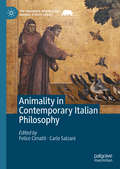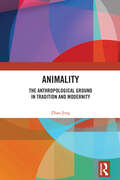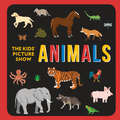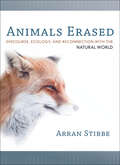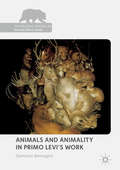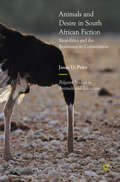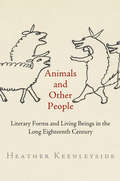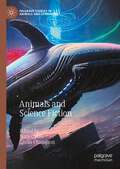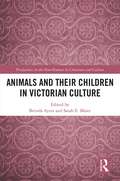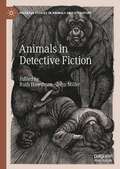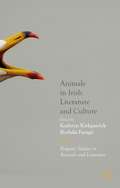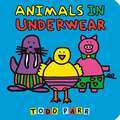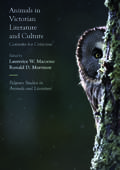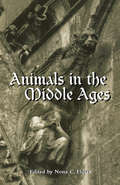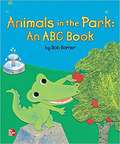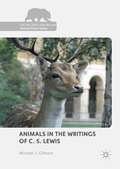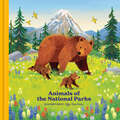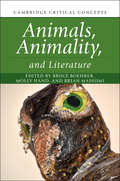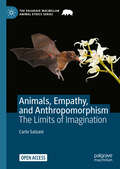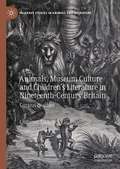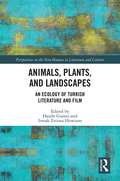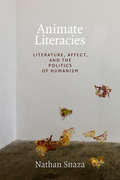- Table View
- List View
Animality in Contemporary Italian Philosophy (The Palgrave Macmillan Animal Ethics Series)
by Carlo Salzani Felice CimattiThis volume provides an overview of contemporary Italian philosophy from the perspective of animality. Its rationale rests on two main premises: the great topicality of both Italian contemporary philosophy (the so-called “Italian Theory”) and of the animal question (the so-called “animal turn” in the humanities and the social sciences) in the contemporary philosophical panorama. The volume not only intersects these two axes, illuminating Italian Theory through the animal question, but also proposes an original thesis: that the animal question is a central and founding issue of contemporary Italian philosophy. It combines historical-descriptive chapters with analyses of the theme in several philosophical branches, such as biopolitics, Posthumanism, Marxism, Feminism, Antispeciesism and Theology, and with original contributions by renowned authors of contemporary Italian (animal) philosophy. The volume is both historical-descriptive and speculative and is intended for a broad academic audience, embracing both Italian studies and Animal studies at all levels.
Animality: The Anthropological Ground in Tradition and Modernity
by Zhao JingBy addressing the Western understanding of the status and nature of animals and the relation of animals to the question of life, this book provides a discourse on animality through an interdisciplinary investigation into various areas of humanities. The nature of animals is explored by drawing on materials from literature, art, religion, philosophy, and political science, focusing on discussions of animality about the classical culture of ancient Greece, metaphysics and its application to debates on life, Martin Heidegger’s philosophical theories, and biopolitics. Although the distinctive difference between human beings from animals has long been emphasized, the author argues that they are inseparable from one another to achieve understanding. The interrogation of animality, therefore, provides a new perspective on the nature of human beings in this postmodern era. Academics in Western literature, literary theory, literary criticism and comparative literature will find this work an insightful addition to debates in their respective fields, whilst it will also help senior university students pursuing their studies.
Animals (The Kids' Picture Show)
by Chieri DeGregorio Steve DeGregorioGet ready for an animal adventure with your little explorer! The Kids' Picture Show books, inspired by the hugely popular YouTube channel, introduce young readers to first words in cool 8-bit style.This sturdy board book, packed with images of animals, is the perfect introduction to creatures from around the world for babies and toddlers. The 8-bit illustration style makes the book even more fun and accessible for young children, and will also appeal to parents, grandparents, and everyone who has played classic video arcade games.
Animals Erased: Discourse, Ecology, and Reconnection with the Natural World
by Arran Stibbe“Amazingly clear and incisive readings of a wide range of discourses related to animals and ecology” from the author of Ecolinguistics (Karla Armbruster, coeditor of Beyond Nature Writing).Animals are disappearing, vanishing, and dying out—not just in the physical sense of becoming extinct, but in the sense of being erased from our consciousness. Increasingly, interactions with animals happen at a remove: mediated by nature programs, books, and cartoons; framed by the enclosures of zoos and aquariums; distanced by the museum cases that display lifeless bodies. In this thought-provoking book, Arran Stibbe takes us on a journey of discovery, revealing the many ways in which language affects our relationships with animals and the natural world. Animal-product industry manuals, school textbooks, ecological reports, media coverage of environmental issues, and animal-rights polemics all commonly portray animals as inanimate objects or passive victims. In his search for an alternative to these negative forms of discourse, Stibbe turns to the traditional culture of Japan. Within Zen philosophy, haiku poetry, and even contemporary children’s animated films, animals appear as active agents, leading their own lives for their own purposes, and of value in themselves.“Those of us of cultures of the land—both working with and, yes, consuming animals—will applaud Arran Stibbe’s analysis of the loss of soul when right relationship is discarded.” —Alastair McIntosh, author of Soil and Soul
Animals Everywhere [Grade 1, Unit 4] (Elementary Core Reading Ser.)
by Donald Bear McGraw-Hill EducationNIMAC-sourced textbook
Animals Small and Huge (Reach Into Phonics Ser.)
by Deborah J. Short Deanne W. Kells Kelsey BruceNIMAC-sourced textbook
Animals and Animality in Primo Levi’s Work (The Palgrave Macmillan Animal Ethics Series)
by Damiano BenvegnùSituated at the intersection of animal studies and literary theory, this book explores the remarkable and subtly pervasive web of animal imagery, metaphors, and concepts in the work of the Jewish-Italian writer, chemist, and Holocaust survivor Primo Levi (1919-1987). Relatively unexamined by scholars, the complex and extensive animal imagery Levi employed in his literary works offers new insights into the aesthetical and ethical function of testimony, as well as an original perspective on contemporary debates surrounding human-animal relationships and posthumanism. The three main sections that compose the book mirror Levi’s approach to non-human animals and animality: from an unquestionable bio-ethical origin (“Suffering”); through an investigation of the relationships between writing, technology, and animality (“Techne”); to a creative intellectual project in which literary animals both counterbalance the inevitable suffering of all creatures, and suggest a transformative image of interspecific community (“Creation”).
Animals and Desire in South African Fiction: Biopolitics and the Resistance to Colonization (Palgrave Studies in Animals and Literature)
by Jason D. PriceThis book considers the political potential of affective experiences of desire as reflected in contemporary South African literature. Jason Price argues that definitions of desire deployed by capitalist and colonial culture maintain social inequality by managing relations to ensure a steady flow of capital and pleasure for the dominant classes, whereas affective encounters with animals reveal the nonhuman nature of desire, a biopower that, in its unpredictability, can frustrate regimes of management and control. Price wonders how animals' different desires might enable new modes of thought to positively transform and resist the status quo. This book contends that South African literary works employ nonhuman desire and certain indigenous notions of desire to imagine a South Africa that can be markedly different from the past.
Animals and Other People: Literary Forms and Living Beings in the Long Eighteenth Century
by Heather KeenleysideIn Animals and Other People, Heather Keenleyside argues for the central role of literary modes of knowledge in apprehending animal life. Keenleyside focuses on writers who populate their poetry, novels, and children's stories with conspicuously figurative animals, experiment with conventional genres like the beast fable, and write the "lives" of mice as well as men. From such writers—including James Thomson, Daniel Defoe, Jonathan Swift, Laurence Sterne, Anna Letitia Barbauld, and others—she recovers a key insight about the representation of living beings: when we think and write about animals, we are never in the territory of strictly literal description, relying solely on the evidence of our senses. Indeed, any description of animals involves personification of a sort, if we understand personification not as a rhetorical ornament but as a fundamental part of our descriptive and conceptual repertoire, essential for distinguishing living beings from things.Throughout the book, animals are characterized by a distinctive mode of agency and generality; they are at once moving and being moved, at once individual beings and generic or species figures (every cat is also "The Cat"). Animals thus become figures with which to think about key philosophical questions about the nature of human agency and of social and political community. They also come into view as potential participants in that community, as one sort of "people" among others. Demonstrating the centrality of animals to an eighteenth-century literary and philosophical tradition, Animals and Other People also argues for the importance of this tradition to current discussions of what life is and how we might live together.
Animals and Science Fiction (Palgrave Studies in Animals and Literature)
by Giulia Champion Nora CastleAnimals and Science Fiction is the first edited collection to be published focusing on the intersection of animal studies and science fiction studies. It offers a broad range of theoretical approaches and primary source texts—including novels, short stories, poetry, film and TV, photography, erotica, video games, and urban planning documents—that explore the ways works of science fiction can transform how we see and interact with nonhuman others. With an eye toward more just multispecies futures, it argues that speculative imaginaries can be pivotal in changing attitudes toward and understandings of nonhuman animals in our world today. Chapters appeal to those interested in biopolitics, posthumanism, new materialism, ecocriticism and the environmental humanities, ocean humanities, postcolonial studies, critical race studies, Indigenous studies, global sf studies, film studies, and food studies. Taken together, the collection works to showcase a diverse and growing field ofscholarly inquiry into animals and science fiction.
Animals and Their Children in Victorian Culture (Perspectives on the Non-Human in Literature and Culture)
by Brenda Ayres Sarah Elizabeth MaierWhether a secularized morality, biblical worldview, or unstated set of mores, the Victorian period can and always will be distinguished from those before and after for its pervasive sense of the "proper way" of thinking, speaking, doing, and acting. Animals in literature taught Victorian children how to be behave. If you are a postmodern posthumanist, you might argue, "But the animals in literature did not write their own accounts." Animal characters may be the creations of writers’ imagination, but animals did and do exist in their own right, as did and do humans. The original essays in Animals and Their Children in Victorian explore the representation of animals in children’s literature by resisting an anthropomorphized perception of them. Instead of focusing on the domestication of animals, this book analyzes how animals in literature "civilize" children, teaching them how to get along with fellow creatures—both human and nonhuman.
Animals in Detective Fiction (Palgrave Studies in Animals and Literature)
by John Miller Ruth HawthornThis book explores the vast array of animals that populate detective fiction. If the genre begins, as is widely supposed, with Edgar Allan Poe’s “Murders in the Rue Morgue” (1841), then detective fiction’s very first culprit is an animal. Animals, moreover, consistently appear as victims, clues, and companions, while the abstract conception of animality is closely tied to the idea of criminality. Although it is often described as an essentially conservative form, detective fiction can unsettle the binary of human and animal to intersect with developing concerns in animal studies: animal agency, the ethical complexities of human/animal interaction, the politics and literary aesthetics of violence, and animal metaphor. Gathering its 14 essays into sections on ontologies, ethics, politics, and forms, Animals in Detective Fiction provides a compelling and nuanced analysis of the central role creatures play in this enduringly popular and continually morphing literary form.
Animals in Irish Literature and Culture
by Kathryn Kirkpatrick Borbála FaragóAnimals in Irish Literature and Culture spans the early modern period to the present, and includes essays exploring some of Ireland's better known animals—birds, horses, pigs, cows, and dogs—as well as its less considered animals—hares, foxes, eels, and insects. The collection also unsettles the boundaries and definitions of 'nation' by exploring colonial, post-colonial, and globalized manifestations of Ireland as country and state as well as the human animal and non-humananimal migrations that challenge a variety of literal and cultural borders. In essays addressing a range of Irish cultural production, contributors consider the impacts of conceptual categories of nature, animality, and humanness on actual human and animal lives. Emerging in the era of the sixth mass extinction, brought on by human-induced climate change and habitat destruction, this volume aims to make a contribution to eco-critical thought and practice in Irish Studies and beyond.
Animals in Underwear ABC
by Todd ParrFrom alligator to zebra - with a goldfish, iguana, yak, and even a unicorn in between - there's no better way to learn the alphabet than with animals... in underwear! Todd Parr's signature kid-friendly illustrations and bold colors showcase an array of animals in all kinds of hilarious underwear styles, making learning the alphabet tons of fun. Featuring a padded cover and gate folds on every spread, here's a playful, silly way for kids to learn their ABCs!
Animals in Victorian Literature and Culture: Contexts for Criticism (Palgrave Studies in Animals and Literature)
by Laurence W. Mazzeno Ronald D. MorrisonThis collection includes twelve provocative essays from a diverse group of international scholars, who utilize a range of interdisciplinary approaches to analyze "real" and "representational" animals that stand out as culturally significant to Victorian literature and culture. Essays focus on a wide range of canonical and non-canonical Victorian writers, including Charles Dickens, Anthony Trollope, Anna Sewell, Emily Bronte, James Thomson, Christina Rossetti, and Richard Marsh, and they focus on a diverse array of forms: fiction, poetry, journalism, and letters. These essays consider a wide range of cultural attitudes and literary treatments of animals in the Victorian Age, including the development of the animal protection movement, the importation of animals from the expanding Empire, the acclimatization of British animals in other countries, and the problems associated with increasing pet ownership. The collection also includes an Introduction co-written by the editors and Suggestions for Further Study, and will prove of interest to scholars and students across the multiple disciplines which comprise Animal Studies.
Animals in the Middle Ages: A Book Of Essays (Routledge Medieval Casebooks #Vol. 13)
by Nona C. FloresThese interdisciplinary essays focus on animals as symbols, ideas, or images in medieval art and literature.
Animals in the Park: An ABC Book [Big Book] (Elementary Core Reading Ser.)
by Bob BarnerNIMAC-sourced textbook <P><P>See what animals like to do in the park at night
Animals in the Writings of C. S. Lewis (The Palgrave Macmillan Animal Ethics Series)
by Michael J. GilmourThis book examines C. S. Lewis's writings about animals, and the theological bases of his opposition to vivisection and other cruelties. It argues Genesis is central to many of these ethical musings and the book's organization reflects this. It treats in turn Lewis's creative approaches to the Garden of Eden, humanity's "dominion" over the earth, and the loss of paradise with all the catastrophic consequences for animals it presaged. The book closes looking at Lewis's vision of a more inclusive community. Though he left no comprehensive summary of his ideas, the Narnia adventures and science fiction trilogy, scattered poems and his popular theology inspire affection and sympathy for the nonhuman. This study challenges scholars to reassess Lewis as not only a literary critic and children's author but also an animal theologian of consequence, though there is much here for all fans of Mr. Bultitude and Reepicheep to explore.
Animals of the National Parks: An Alphabet Book
by Fifty-Nine ParksFor nature lovers of any age, this book is a beautiful A-to-Z introduction to the wild and wonderful animals that live in America's national parks. Featuring art from the beloved printmakers and poster illustrators at Fifty-Nine Parks.America's national parks are some of the most magical places in the world, and home to a diverse array of creatures, both well known and more unusual. From American Bison (which are also the largest mammals in the parks) to flying squirrels (which can glide the length of a football field) to Xeme (which take two full years to grow their adult feathers), this picture book takes children on an enchanting alphabetical adventure through the natural world.The book features fascinating facts about each animal, including information on where they can be found. A passport page to record visits and an illustrated map of all the national parks will encourage children and their families to make the most of every trip. With beautifully evocative art that's nostalgic yet contemporary, this is a special gift for outdoor and national park lovers of all ages.
Animals, Animality, and Literature (Cambridge Critical Concepts)
by Brian Massumi Bruce Boehrer Molly HandAnimals, Animality, and Literature offers readers a one-volume survey of the field of literary animal studies in both its theoretical and applied dimensions. Focusing on English literary history, with scrupulous attention to the interplay between English and foreign influences, this collection gathers together the work of nineteen internationally noted specialists in this growing discipline. Offering discussion of English literary works from Beowulf to Virginia Woolf and beyond, this book explores the ways human/animal difference has been historically activated within the literary context: in devotional works, in philosophical and zoological treatises, in plays and poems and novels, and more recently within emerging narrative genres such as cinema and animation. With an introductory overview of the historical development of animal studies and afterword looking to the field's future possibilities, Animals, Animality, and Literature provides a wide-ranging survey of where this discipline currently stands.
Animals, Empathy, and Anthropomorphism: The Limits of Imagination (The Palgrave Macmillan Animal Ethics Series)
by Carlo SalzaniThis open access book explores the role of imagination in animal ethics and its constitutive links to empathy/sympathy and anthropomorphism. The book argues for the constitutive role of imagination in ethical deliberation, but acknowledges that there exist important limits to its use. However, &“limit&” is here understood not merely negatively as restriction and insufficiency, but rather positively as &“condition of possibility,&” so what the book explores and analyses are the conditions for a positive and fruitful use of the imagination in ethics. The book uses as a &“frame&” the questions and issues raised in J.M. Coetzee&’s The Lives of Animals to explore some central and salient themes.
Animals, Museum Culture and Children’s Literature in Nineteenth-Century Britain: Curious Beasties (Palgrave Studies in Animals and Literature)
by Laurence TalairachAnimals, Museum Culture and Children’s Literature in Nineteenth-Century Britain: Curious Beasties explores the relationship between the zoological and palaeontological specimens brought back from around the world in the long nineteenth century—be they alive, stuffed or fossilised—and the development of children’s literature at this time. Children’s literature emerged as dizzying numbers of new species flooded into Britain with scientific expeditions, from giraffes and hippopotami to kangaroos, wombats, platypuses or sloths. As the book argues, late Georgian, Victorian and Edwardian children’s writers took part in the urge for mass education and presented the world and its curious creatures to children, often borrowing from their museum culture and its objects to map out that world. This original exploration illuminates how children’s literature dealt with the new ordering of the world, offering a unique viewpoint on the construction of science in the long nineteenth century.
Animals, Plants, and Landscapes: An Ecology of Turkish Literature and Film (Perspectives on the Non-Human in Literature and Culture)
by Hande Gurses Irmak Ertuna HowisonThe landscape of Turkey, with its trees and animals inspires narratives of survival, struggle and escape. Animals, Plants, and Landscapes: An Ecology of Turkish Literature and Film, will be the first major study to offer fresh theoretical insight into this landscape, by offering a collection of analyses of key texts of Turkish literature and cinema. Through discussion of both classical and contemporary works, this volume, paves the way for the formation of a ecocritical canon in Turkish literature and the rise of certain themes that are unique to Turkish experience. Snakes, fishermen and fish who catch men, porcupines contemplating on human agency, dogs exiled on an island and men who put dogs to fights, goat herders and windy steppes of Anatolia are all agents in a territory that constantly shifts. The essays included in this volume demonstrate the ways in which the crystallized relations between human and non-human form, break, and transform.
Animate Literacies: Literature, Affect, and the Politics of Humanism (Thought in the Act)
by Nathan SnazaIn Animate Literacies Nathan Snaza proposes a new theory of literature and literacy in which he outlines how literacy is both constitutive of the social and used as a means to define the human. Weaving new materialism with feminist, queer, and decolonial thought, Snaza theorizes literacy as a contact zone in which humans, nonhuman animals, and nonvital objects such as chairs and paper all become active participants. In readings of classic literature by Kate Chopin, Frederick Douglass, James Joyce, Toni Morrison, Mary Shelley, and others, Snaza emphasizes the key roles that affect and sensory experiences play in literacy. Snaza upends common conceptions of literacy and its relation to print media, showing instead how such understandings reinforce dehumanizations linked to dominant imperialist, heterosexist, and capitalist definitions of the human. The path toward disrupting such exclusionary, humanist frameworks, Snaza contends, lies in formulating alternative practices of literacy and literary study that escape disciplined knowledge production.
